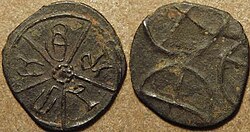|
Kannada inscriptions
  About 25,000 inscriptions found in Karnataka and nearby states[1] belong to historic Kannada rulers, including the Kadambas, the Western Ganga Dynasty, the Rashtrakuta, the Chalukya, the Hoysala and the Vijayanagara Empire. Many inscriptions related to Jainism have been unearthed. The inscriptions found are generally on stone (Shilashasana) or copper plates (Tamarashasana). These Kannada inscriptions (Old Kannada, Kadamba script) are found on historical hero stones, coins, temple walls, pillars, tablets and rock edicts. They have contributed towards Kannada literature and helped to classify the eras of Proto Kannada, Pre Old Kannada, Old Kannada, Middle Kannada and New Kannada. Inscriptions depict the culture, tradition and prosperity of their era. The literature of Ramayana and Mahabharata are transferred through the generations by these inscriptions. The Hazara Rama Temple and Aranmula Parthasarathy Temple are the best examples of temples associated with Kannada inscriptions. Earliest Kannada inscriptions  The stone inscription (dated 370 CE) found at Talagunda near Shiralakoppa in the taluk during excavation by the Archaeological Survey of India (ASI) in 2013-14 is now said to be the earliest Kannada inscription.[2] Nishadi Inscription of 400 AD of Chandragiri hill (Shravanabelagola), Halmidi inscription of 5th century AD[3][4] and Aihole inscriptions are very important in the history of Kannada and Karnataka. 5th century Tamatekallu inscription of Chitradurga and 500 CE Chikkamagaluru inscription. The earliest known Kannada inscription in Bengaluru region traced to the reign of Sripurusha was discovered in 2018 in Hebbal.[5] There are few Kannada words found in the edicts and inscriptions those are prior to the Christian era in places as far as Egypt.[6]
Ashoka rock edict at Brahmagiri in Chitradurga district is the ancient site of Ishila. An inscription there contains this most ancient Kannada word. The earliest recorded word of Kannada is Isila occurring in the Brahmagiri rock inscription of 252 BC (similar to many other inscriptions with Kannada words).[7]
A Dr. S. Shettar completed a detailed palaeographic study over 10 years, finding five to six inscriptions that are older than Halmidi inscription (in Poorvada Halegannada dialect). The inscription is a mix of Brahmi, Kannada and Nagari scripts. One of those found at Tagarthi (within the Gangavadi region in Shimoga district) dates to 350 AD, during the Ganga dynasty. This study pushed the date push back by at least a century. The historian Suryanath Kamath also agree with the findings of Dr S. Shettar.[8]
M. G. Manjunath an epigraphist Mysore based scholar discovered 400 AD Gunabhushitana Nishadi inscription of Jainism one of the 271 inscriptions on Chandragiri hill of Shravanabelagola found near Parshwanatha Basadi, which is 50 years older than Halmidi inscription. It is mentioned in the Epigraphia Karnataka. There are Prakrit, Sanskrit and Purvada Halegannada (Old Kannada words. The four lined inscription has six words. The inscription is in Shatavahana Brahmi and Aadi Ganga script. M. Chidananda Murthy also agree that Gunabhushitana Nishadi Shasana was a Kannada inscription (in Purvada Halegannada script).[9]
The 5th century AD[3][4] Halmidi inscription 16-line earliest Kannada inscription found at Halmidi in Belur taluk of Hassan district on rectangular sandstone ( 2.5 ft height and 1 ft width) has a Vishnu Chakra on its top. The language of the inscription is in Poorvada Halegannada ( Proto-Kannada). Archaeologist M. H. Krishna found the Brahmi script in the inscription. Shifted the inscription to Archaeological Museum, Mysore and later to Government Museum in Bangalore. Epigraphia Karnataka has dedicated a chapter to study of the inscription. The linguists and writers Govinda Pai, M. Chidananda Murthy, T. V. Venkatachala Sastry, Ram Sri Mugali, R.S. Panchamukhi, D.L. Narasimhachar, and M. M. Kalburgi studied the inscription and published papers. Writers including G. S. Gai, T. A. Gopinatha Rao, T. N. Srikantaiah, Shivarama Aithala, S. Nagaraju, S. Srikanta Sastri, M. Mariyappa Bhatta, M. B. Neginahal, K. V. Ramesh, Devarakondareddy and K. M. Hanumantha Rao have discussed the important issues raised by Halmidi inscription in their books.[10]
Chitradurga district is home for most ancient inscriptions written in archaic Kannada script. As per epigraphist Dr. B. Rajashekharappa the inscriptions known as Veeragallu at Tamatakal village written in Kannada script belongs mostly to end of Fifth Century or beginning of Sixth Century, describes the nature and achievements of Gunamadhura who ruled Masikapura (ancient name of Tamatakal), he was frivolous, generous and kind person. he was a favourite among women (Despite being of dark complexion), because of his kind nature. In 1903 by the historian late B. L. Rice discovered the inscriptions, Dr. Rajashekharappa found new aspects.[11] Karnataka inscriptions of Kannada dynasties The Karnataka inscriptions are categorized as follows:

Kannada copper plates and manuscripts
Coins bearing Kannada inscription
Kannada inscriptions found outside Karnataka Many Kannada inscriptions are found outside Karnataka, mainly in Maharashtra, Tamil Nadu and Andhra Pradesh. Kannada inscriptions found in Andhra PradeshAndhra Pradesh has numerous Kannada inscriptions.[16]
Kannada inscriptions found in Maharashtra
Kannada inscriptions found in Tamil NaduThe Kannada inscription of Rashtrakuta king Krishna III period (of Tenth century CE) found at Melpadi village in Vellore district of Tamil Nadu. It is mentioned as the endowment was made in the presence of Krishna III's feudatories (Rattas and Bitti Raja of Melpadi). Krishna III was praised as Akalavarsha Deva, Prithvi Vallabha, Maha Rajathiraja, Parameshvara, Parama Bhattaraka and Chaleka Nallathan and it indicats that he was about to accomplish his conquests of Kancheepuram and Thanjavur.[19] The Kannada inscriptions found at Kanchipuram, Dharmapuri region, Vazhaithottam in Nilgiri District, Jain Palli at Alathur in Avinasi taluk, Coimbatore District and Karamadai copper plate inscription.[22] Avinashi Temple inscription in Coimbatore, Kanchi inscription of Vikramaditya, Sittannavasal inscription, Melpadi inscription of Rastrakuta Krishna III, Madras Kannada Herostone inscription, Kodumbalur inscription of Irukkuvelir Chiefs and Hero-stone inscriptions in Kondaharahalli are the inscriptions in Kannada.
Research institute of Kannada manuscriptsPeople associated with Kannada inscriptions and manuscripts
See also
References
Works cited
External links
|

